

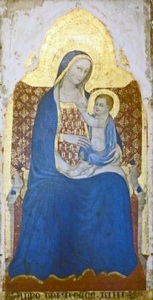
This master is named for a panel (1409) of the Madonna and Child enthroned in the Musée du Petit Palais, Avignon, which is dated by inscription. It was first documented in 1863, when it was in the collection of Giovanni Pietro Campana: he had been the Director of the Bank of the Monte di Pietà in Rome and amassed a considerable fortune and in important collection of antiquities and fine art before he was disgraced and exiled in 1857. Most of the paintings in the collection, including this panel, were sold to the French government in 1863 and exhibited in the Musées des Thermes et de l’ Hotel de Cluny, Paris. They were transferred to the museum at Avignon in 1976.
Federico Zeri (referenced below) suggested that this was the central panel of a polyptych, and associated it with:
-
✴panels depicting SS Andrew, Catherine of Alexandria, John the Evangelist and Augustine in the Pinacoteca Vaticana, Rome; and
-
✴four predella panels depicting scenes from the life of St Augustine in the Alte Pinakothek, Munich.
All of these panels are illustrated in the website of the Fondazione Federico Zeri. Zeri also suggested that the polyptych was originally in Sant’ Agostino, Narni.
A number of works, predominantly in Narni, are attributed to this master and his workshop.
Narni
Frescoes in San Giovenale (ca. 1400)
Federico Zeri and subsequently Corrado Fratini (referenced below) attributed the following frescoes in San Giovenale to the Maestro di Narni del 1409:
Frescoes in the Apse
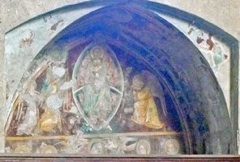
Traces of frescoes survive in the chapels in the walls of the apse, but most of them are no longer visible. An exception are the frescoes in the second bay from the left (illustrated above), which depict:
-
✴very damaged figures of the Annunciation, in the spandrels;
-
✴Christ in glory with angels, in the lunette;
-
✴the Madonna and Child with SS Francis, Andrew, Catherine of Alexandria and Paul in the middle register, of which only the upper part is visible; and
-
✴the Crucifixion and four scenes from the life of St Giles in the lower register, which is now completely hidden from view.
St Giles seems to have been the founder of a monastery at Saint-Gilles-du-Gard, which still possesses his presumed relics. The monastery became an important pilgrimage site. The Angevins probably introduced the cult to Southern Italy, and it might well have become popular in Narni during the period 1403-14, when the city was controlled by King Ladislas of Naples. This bay of the apse might well have been the location of the chapel dedicated to St Giles that was documented in 1407.
Madonna and Child with angels
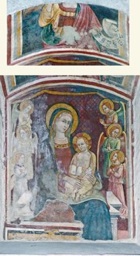
-
✴The niche was originally deeper, so only the lower half of a figure of the Redeemer survives on the upper surface. This includes the bleeding wound in His side.
-
✴The main panel depicts the upper part of a figure of the Madonna and Child enthroned with angels.
Frescoes in San Francesco (ca. 1400)
A number of frescoes in San Francesco are attributed to the Maestro di Narni del 1409:
St Francis
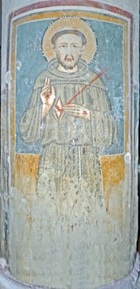
Madonna and Child

Madonna and Child with Saints
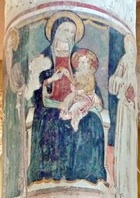
St George
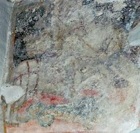
Madonna and Child
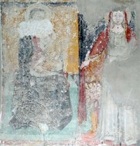
Frescoes
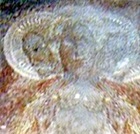
-
✴the Trinity, using the iconography of the three-headed Christ (illustrated here); and
-
✴ St John the Baptist .
Frescoes in San Domenico (ca. 1400)
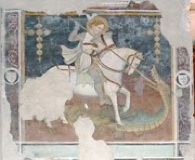
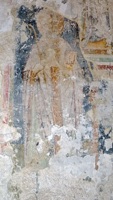
These frescoes on the counter-facade of of San Domenico, which are attributed to the Maestro di Narni del 1409, depict;
-
✴St George and the dragon (to the left of the portal); and
-
✴St Hugo enthroned (to the right of the portal).
Processional Banner (ca. 1400)
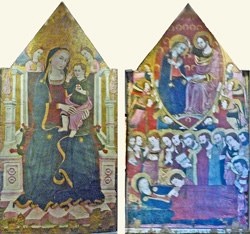
This double-sided panel, which is attributed to the Maestro di Narni del 1409, seems originally to have served served as a processional banner. It was first recorded in 1872 in the sacristy of San Domenico, although this was not necessarily its original location. It could be the banner from Santa Maria Impensole that was used in the annual procession held on the feast of the Assumption of the Virgin.
The panel, which was restored in 1989, depicts:
-
✴ the Madonna and Child enthroned; and
-
✴the Dormition of the Virgin, with her Coronation above.
Frescoes in Santa Maria Impensole (ca. 1400)
The recent restoration of Santa Maria Impensole has revealed a number of interesting frescoes on the right wall, some of which are attributed to the Maestro di Narni del 1409:
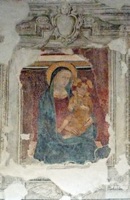
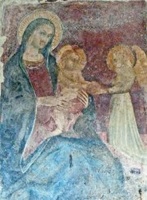
-
✴two frescoes of the Madonna and Child, in one of which the baby Jesus reaches towards an angel; and
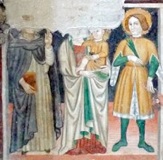

-
✴a damaged fresco of the Madonna and Child with SS Peter Martyr and Ansanus. As is clear from the detail of St Ansanus (kindly sent to me by Signor Giuseppe Fortunati), he holds what is probably a heart and trachea in his left hand, symbolising the manner of his death.
Madonna del Latte with saints (ca. 1400)

This fresco in a niche behind the high altar of Santa Maria del Piano is attributed to the Maestro di Narni del 1409. The fresco, which depicts of the Madonna del Latte with SS James and Catherine of Alexandria, is probably the miraculous image for which the church was built.
Madonna and Child (ca. 1440)

Otricoli
Frescoes in Santa Maria Assunta (ca. 1400)
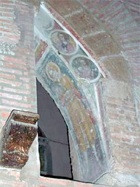
Terni
Madonna and child with saints (ca. 1400)
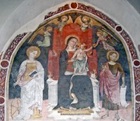
Miracles during the Bianchi March
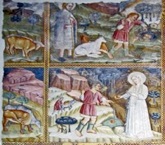
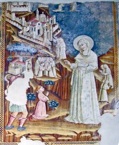
This important fresco cycle in Santa Maria del Monumento is variously attributed to the Maestro della Dormitio di Terni or the Maestro di Narni del 1409.
Read more:
F. Zeri, “Un Pittore di Narni del 1409”, Paragone 9 (1958) 3-9
C. Fratini, “I Dipinti della Cattedrale di San Giovenale dal XIII Secolo al Primo Quattrocento e il Contesto Pittorico Narnese nel Tardo Medioevo”,
in C. Perissinotto (Ed.), “San Giovenale. La Cattedrale di Narni nella Storia e nell' Arte. Atti del Convegno di Studi (1996)”, (1998) Narni pp 201-25

